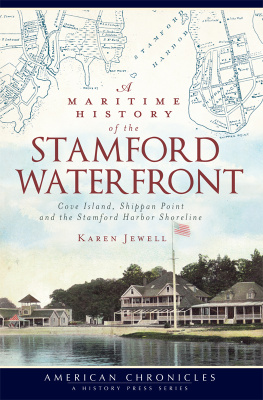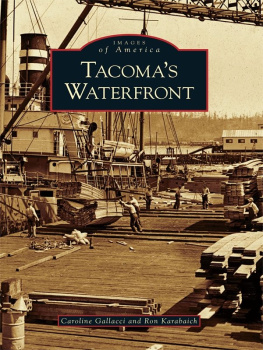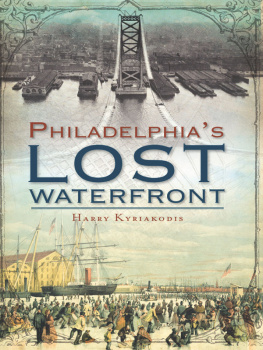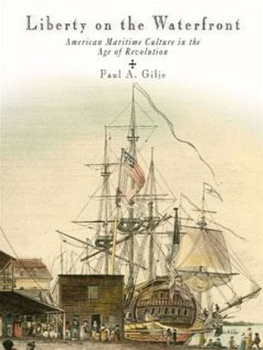

Published by The History Press
Charleston, SC 29403
www.historypress.net
Copyright 2010 by Karen Jewell
All rights reserved
First published 2010
e-book edition 2012
ISBN 978.1.61423.279.7
Jewell, Karen.
A maritime history of the Stamford waterfront : Cove Island, Shippan Point and the
Stamford harbor shoreline / Karen Jewell.
p. cm.
Includes bibliographical references.
print edition ISBN 978-1-60949-075-1
1. Stamford (Conn.)--History. 2. Waterfronts--Connecticut--Stamford--History. 3. Yachting--Connecticut--Stamford--History. 4. Stamford Region (Conn.)--History, Local. 5. Long Island Sound (N.Y. and Conn.)--History, Local. I. Title.
F104.S8J48 2010
387.097469--dc22
2010045528
Notice: The information in this book is true and complete to the best of our knowledge. It is offered without guarantee on the part of the author or The History Press. The author and The History Press disclaim all liability in connection with the use of this book.
All rights reserved. No part of this book may be reproduced or transmitted in any form whatsoever without prior written permission from the publisher except in the case of brief quotations embodied in critical articles and reviews.
Contents
Acknowledgements
During the process of writing A Maritime History of the Stamford Waterfront, I was very fortunate to have a handful of people who would answer my numerous phone calls and seemingly endless questions without even a hint of annoyance in their responses. All of these invaluable resources could have easily shrugged me off at any point in time, as they certainly had enough to do in their own business and personal lives. Instead, they graciously helped me in numerous ways in my quest to gather just the right information for the project. For that, I am extremely grateful.
In no particular order, I would like to express my sincere appreciation to the following nautical aficionados for the generous donation of their time, data, images and, above all, patience in helping me to complete the task at hand: Ron Marcus, for steering me in the right direction during the beginning stages of research; Skip Raymond, for not blocking my phone number on his caller list and for working with me on finding the pieces to a couple of important puzzles; Tom Anderson, for being kind enough to allow me access to a variety of archived photos and historical records; Christopher Meek, for supplying much-needed images; Nellie Guernsey, for making it possible to include a vital component of the local maritime heritage; and my mother and father, whose enduring support continues to fuel my own enthusiasm.
Introduction
When I initially set out to write this book, my thought was, What an easy project this will be! That overly confident sentiment was borne from the innate connection that I felt I had with the citys shoreline. For nearly twenty years previous, my experiences had included anything and everything nautical, from positions as dock master to charter broker to yacht broker to running a successful boat maintenance business. Presumably, or so I thought, there would certainly be more than enough information available for the job at hand.
Shortly after embarking on the research process, however, it became painfully apparent that the voyage from Point A to Point B was not going to be quite as straight of a line as originally hoped. Although there have been volumes upon volumes of excellent literary pieces published in the past by accomplished and recognized authors regarding the history of Stamford as a whole, there seems to be very little about the waterfront specifically. While lamenting about this realization one day with Stamford historian Ron Marcus, he was able to offer a rather insightful and enlightening observation that his wife had once shared.
She said, It is because all of the books have been written by landlubbers! By George, I think shes got it.
Once that important piece of information was understood and accepted, the entire endeavor began to take on a whole new shape. Clearly, there was going to be a lot more work required on my part than first expected if this was, indeed, going to become a reality. And, obviously, making it a reality was the plan.

The sailboat Palawan, a regular on the Stamford sailing scene. Courtesy of Hathaway, Reiser & Raymond.
So forward it was, and as fate would have it, the journey ultimately turned out to be far more exciting than I could ever have imagined. What was already a fascinating subject to begin with became an even more intriguing topic the further I dug. With a little patience, history generously revealed itself in a grand way. Perhaps it had simply been waiting for someone who was a bit less of the landlubber sort to pick up the pen.
Chapter 1
The Beginning Years
The area that we now know as Stamford, Connecticut, originally went by the name of Rippowam, which had been given by the Native Americans who first prospered there. As the Europeans began to discover the region, they continued to use Rippowam until April 6, 1642, when it was officially changed to Stamford. It is believed that the choice of Stamford comes from the English settlers desire to honor the existing city of Stamford in Lincolnshire, England.
A formal deed to the city was signed on July 1, 1640, with the key players in attendance during that transaction being Captain Turner, representing the New Haven Colony, and Chief Ponus, who stood on behalf of the Indian tribes that occupied the New Canaan and North Stamford territories at the time. As a thank-you for the approximately seven- by eleven-mile parcel of land that ran north to south from current-day Bedford, New York, to Long Island Sound and east to west from the Five Mile River to the Mianus River, Captain Ponus accepted an estimated gift of twelve coats, twelve hoes, twelve hatchets, twelve glasses, twelve knives, four kettles and four fathoms of white wampum. As time went on, however, the Native American inhabitants realized that they could have received much more in exchange for their precious land, and ultimately a larger sum was agreed upon by all sides in 1700. From that point on, Stamford began to truly evolve as a settled community.
Agriculture was an innate characteristic of the region; settlers could produce a variety of healthy and abundant crops. The waterfront, though, turned out to be one of the citys primary sources for lucrative commerce, due to its naturally wide and easily accessible harbor, as well as its proximity to the hustling and bustling island of Manhattan. As the shipping trade industry began to grow along the shoreline, other maritime-related businesses also started to flourish. As a direct result of supply and demand, the necessity for shipbuilders, carpenters, barrel makers, sailmakers, ship store chandlers and a variety of other occupations related to yachting increased at a steady rate.
With this new influx of working coastal residents also came the need for more homes to be built along the waterfront. As the economy improved, the allure of the shoreline began extending beyond just those who made their living from the sea. Residents of New York City soon began purchasing properties in the Shippan and Cove areas, and life along the harbor was quickly becoming a major attraction within the city limits.
Next page











